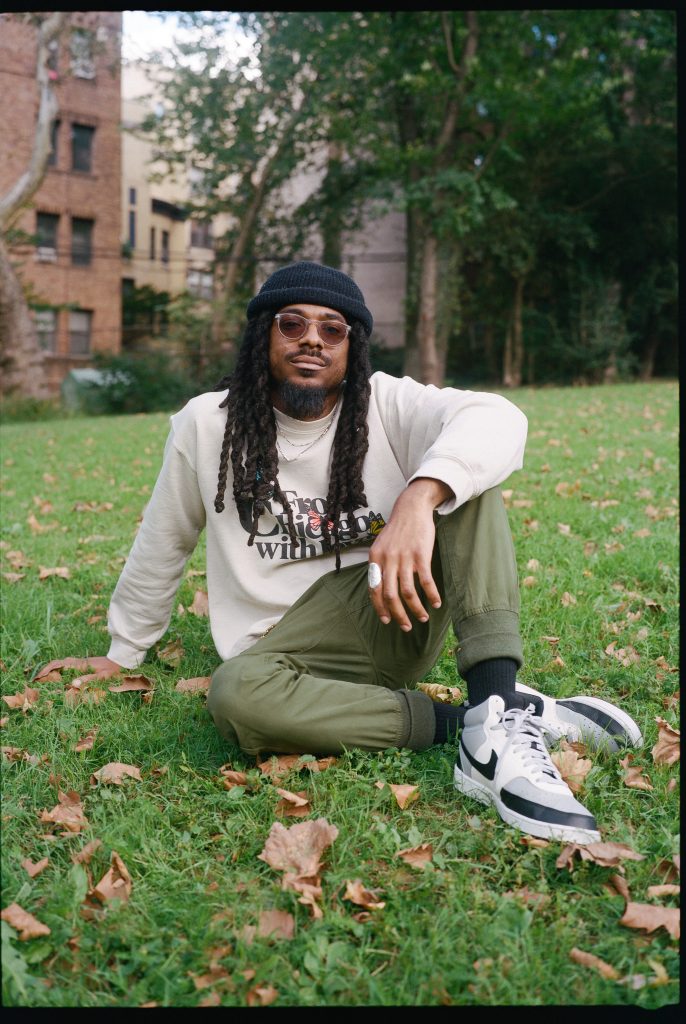Joel Ross has amassed a dedicated following by creating music you have to lean into. That doesn’t
make it any less palatable, but across the vibraphonist’s recorded output — 2019’s KingMaker, 2020’s
Who Are You?, and 2022’s The Parable of the Poet — the compositions were somewhat complex, and
ushered the virtuosity of his band’s live performance to a studio setting. For nublues, his remarkable
fourth release as a leader for Blue Note, Ross challenged himself to create an album with a greater
degree of accessibility — still intricate and adventurous, but with a strong emphasis on melody,
ballads, and the blues. On purpose, nublues feels familiar, like you’ve already heard these songs in
Greenwich Village somewhere. Though there are covers on this LP (John Coltrane’s “equinox” and
“central park west”; Thelonious Monk’s “evidence”), this collection of newly written material
exemplifies the bandleader’s evolution.
“A lot of my music has been more musician-focused with a lot of time and tempo manipulations,
which may not always translate to easy listening for your everyday listener,” he explains. As a result,
nublues finds Ross attempting to adhere to his musical ideologies while putting his own
interpretation on traditional jazz.
The genesis of nublues dates back to 2020 when, during the Covid pandemic as live performances
were shut down, Ross went back to the New School to finish his degree. One of his classes was taught
by the alto saxophonist Darius Jones, who nudged students to dig into the history of the blues. That
led Ross down a rabbit hole of what the blues can be; it isn’t just a 12-bar form. He realized it was a
feeling. “Sort of a spirit or an energy,” Ross says. “It’s emotion, it’s expression. But I also want to stay
true to the rhythmic ideations that we’ve already been developing.”
The blues also had a literal meaning in the creation of this album. The melancholy of isolation made
its way to the arrangements; one can hear the uncertainty of time clashing with the optimism of
brighter days. Partially inspired by his partner, the flutist Gabrielle Garo, he would have
conversations with her family about what creative accessibility looks like in modern music. “It’s this
idea of not exactly changing who we are or how we want to play, but still trying to remain inviting to
people,” Ross says. “So I took it as a personal challenge to figure out how I can write music that is
accessible, that people can follow, and we don’t have to feel like we can’t be ourselves.” The
arrangements collected for this album incorporate singable melodies that retain the spirit of the
blues — evocative jazz through a modern lens.
With his longtime band Good Vibes featuring fellow Blue Note artist Immanuel Wilkins on alto
saxophone, Jeremy Corren on piano, Kanoa Mendenhall on bass, and Jeremy Dutton on drums,
nublues finds the band in rhythmic synergy, the type of improv that only comes after internalizing the
sheet music so they can go off-script. The fellowship arises in the transition from “equinox” to
“mellowdee,” a looping melody bridging the former song to the latter. That wasn’t planned. “We
never talked about it,” Ross says. “We would just be playing these gigs and we try it once and come back to it the next gig and try it again. A lot of what happens on the record are things that have
developed over time.”
nublues is meant to replicate the flow of the band’s live shows. He crafted the album to resemble a
film with gorgeous shots. When played in sequence, it’s a mosaic that feels vibrant, yet serene. The
opening song “early” represents the introductory scene, a canvas for the players to introduce
themselves while setting a tone for the album as a whole. The LP then moves into “equinox,” a
swanky rendition of the Coltrane classic designed as a hard reset following the record’s melancholy
intro. “mellowdee” is the album’s most expansive piece, an 11-minute meditation with four sections
that conveys the band’s members’ connectivity.
Garo makes a special guest appearance on flute for a trio of pieces including “bach (God the Father in
Eternity),” which injects the sound the church and the rhythm of Black American music into a melodic
fragment by J.S. Bach, and “chant,” a mesmerizing multi-layered duet featuring Ross on piano that he
singles out as one of his favorites. “It’s the first time my partner and I are performing alone together
on a recording, and I love the way that our ideas took shape.”
The title track “nublues” unites the spirit of the blues with the unbridled nature of free jazz,
eventually morphing into the brightly swinging piece “ya know?” before transitioning into a highwire
performance of “evidence.” “I don’t really tell the band how to play anything,” Ross says. “What I do
tell them is to stay connected and make everything we do related to each other. And play the blues,
however that comes off.”
In that way, nublues is a vast record with various entry points, an invitation to choose your own
adventure. So when asked what he wants to convey with this LP, Ross hesitates. “I don’t want my
personal experience to be what people are thinking about when they’re experiencing it,” he says. “I
generally want people to be able to come in and hear the music and interpret it through their own
lens.”
Still, the album represents a personal and artistic awakening for Ross and is a rightful next step in
what’s already one of the best stories in jazz.
“I enjoyed the journey of diving into learning about the blues and understanding the history of the
blues, really focusing on developing this band’s sound and band structure,” he says. “For me, it was
just about the journey that came from getting into all of the information and figuring out what it was
going to be. It’s a constant continuing. It’s a snapshot into how we’ve continued to do the same thing
we’ve been doing and how it’s been shifting.”

